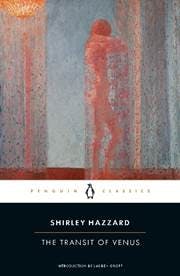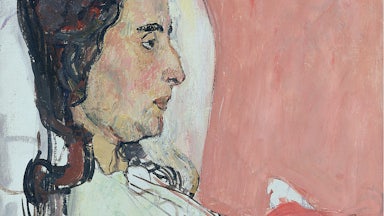The astronomical event referenced in the title of Shirley Hazzard’s novel The Transit of Venus occurs in two installments—eight years apart, every 243 years—when Venus passes between Earth and the nearest star twice. For a short while, Venus is visible on Earth in the form of a little black dot traversing the face of the sun.

The history of human attempts to observe and document this phenomenon consists of many misunderstandings and struggles. Flaws in telescopy caused optical illusions that astronomers mistook for atmospheric phenomena, throwing off their measurements, while others waited lifetimes to see it—only for the clouds to gather for the duration. Jean-Baptiste Chappe d’Auteroche died of yellow fever trying to see the 1769 transit in what is today Baja California in Mexico. Ten years before he was killed in Hawai’i, James Cook traveled to Tahiti to observe a transit while also undertaking a covert mission for the British, who were prospecting for new colonies.
It’s Cook’s story that brings the transit of Venus into Hazzard’s novel. The scene is the 1950s English countryside, and two Australian sisters, Grace and Caro, are being condescended to across the lunch table by a snobby professor named Sefton Thrale (“a jutting crag on which a collar and tie, and spectacles, had been accurately placed”). The other guest is a young astronomer named Ted, whose unrequited love for Caro will eventually structure the entire book.
“Why did James Cook set sail in H.M.S. Endeavour for undiscovered Australia if not to observe,” Thrale asks, “en route, at Tahiti, the planet Venus as it crossed the face of the sun on the third of June 1769 and thus to determine the distance of earth from sun?” Caro manages to get a word in, demonstrating that she knows all about it, but he continues his lecture regardless. His speech is meant as an insult based on Caro’s Australian origins and her gender—she’s a beautiful young woman, like Venus in Roman mythology. She’s a goddess of love to Ted, but an unimportant speck to Thrale. Ted interrupts Thrale to defend her with a heroically deniable riposte: Cook’s “calculations were hopelessly out,” he says. “Calculations about Venus often are.”
As Alice Gregory observed in a long essay on Hazzard published in The New Yorker last November, such “contrasts in scale—individual and historical, intimate and epic” are a hallmark of Hazzard’s writing. Deceptively genteel on the surface, her novels gesture at vast and intricate political problems. What begins “demurely enough, all weak tea and lace curtains,” Gregory wrote, “grows quietly comic, and then abruptly calamitous.” Just so, the lunch table Venus scene provides an obsessively detailed account of a few moments, structured by a very barbed code of manners, and gestures at hundreds of years of colonial history, the gendered mythology that we use to label the heavens, and the millions of miles traveled by celestial bodies.
Reissued this March by Penguin Classics with a new introduction by Lauren Groff, the new edition is a treat for new fans drawn in by the critical revival surrounding the publication of Hazzard’s collected stories last year. The Transit of Venus (1980) was the greatest of her three novels, which include The Great Fire (2003) and The Bay of Noon (1970). Implicitly defending Hazzard against a rude prepublication review in Publishers Weekly, which called her stories “quaint antiques from a bygone time,” Gregory, Groff, and other Hazzard advocates have praised her flair as a worldbuilder while marveling at the strangeness of her place in the culture. Hazzard, who was born in Australia in 1931, wore her hair in a bouffant until her death in 2016, for example, and maintained a similar defiance against casualness or trendy novelty in her fiction, which have given her the odd reputation of a relic of a bygone literary era.
And yet her sharp ear for conversation, and eye for the defining political moment in a social interaction, makes her a novelist well suited for our times when novels about personal autonomy in the context of larger political systems are so popular. Readers are coming to see that Hazzard wrote about her own lifetime as a cosmopolitan and professional woman and simply published late. If her work initially seems dated, it may be because The Transit of Venus was published in 1980, when she personally was an unfashionable middle-aged woman who appeared to leave fussiness and drawing rooms in her wake.
Hazzard’s work is often said to be set in “exotic” locations, flitting between Sydney and New York and London and, in The Transit of Venus, an unnamed Latin American country. But it’s also a reflection of Hazzard’s own years spent bouncing around the colonial and postcolonial world, a life more of displacement than glamour. Hazzard hated Australia, where her family settled in the 1920s before moving to Hong Kong after World War II, and she hated the United Nations, where she then worked for years in her twenties. She was 16 when she visited Hiroshima, two years after the Allied bombing—an experience she has Caro undergo, as well.
Hazzard has never had a big reputation as a political writer, but her anti-authoritarian, anti-imperial, and generally anti-bureaucratic politics hold a special appeal in our own apocalyptic times. As Caro’s story develops and the years pass—the novel stretches late into the twentieth century and deep into the Australian sisters’ middle age—an acid commentary on American and British hegemony in global politics develops.
Caro’s brother-in-law, the idiot son of Sefton Thrale, is for example “given Africa” by the Cabinet Office. Totally without a political conscience, he rises through the ranks of government “as if he were a cake or loaf of bread.” Through Caro, Hazzard continually seeks out the rules of Englishness, that unquantifiable and intangible substance that people thought gave them the right to carve the world up. It extends to the mutilation of history: Caro obsesses over the way she was trained in the history of British kings and queens as a child in far-off Australia. “Britain had shared its squalor readily enough with far Australia, though withholding the Abbey and the Swan of Avon,” she writes. The “Swan” was Ben Jonson’s epithet for Shakespeare, England’s ultimate proprietary cultural export—a maker of the kind of beauty that children all over the empire were forced to admire, though with the kind of admiration that makes the geographical and cultural distance between colony and metropole abundantly clear. The very title of Hazzard’s book has a colonial aspect—the flickering appearance of a large and tentacled entity—since it brings in Cook’s reconnaissance mission in service of Australia’s capture.
Although Hazzard’s love of adverbs merits a comparison to Henry James, her combination of apocalyptic global politics with a satire on English manners most closely resembles Evelyn Waugh, whose finest and most bitter novel, A Handful of Dust, features a dull-witted Englishman surprised to die alone and desperate in the Amazon rain forest. But she’s not always so fine a stylist. At moments of profound sincerity she can tend toward the overwrought or even soppy. Grace gets caught in the rain with an attractive doctor, for example, and Hazzard writes: “‘Shall we get to shelter?’ As if they had not already got to shelter.”
Her approximations of working-class speech are also cringeworthy. The character of Ted gains much of his rugged strength of spirit from his working-class roots, while his antagonist Paul Ivory is a feckless toff. Hazzard has Ted recall his mother’s speech through the mists of time occasionally. She speaks to him in a near pastiche of a dialect about the travails of her life: a dead baby cousin (“tha never saw our Lorne, that was Cece’s only girl and died of the lungs, very month tha was born”) and her astonishment at riches (“I’d never seen the like of two pound let alone three”). Through Caro, Hazzard acknowledges her difficulties with handling serious topics directly, rather than obliquely, in writing through satire: “Caro stopped writing, and read the passage over. How sincere, judicious. How much easier it is to sound genuine when being derogatory.”
Against her will, the derogatory is where Hazzard shines. Although Caro can drift into the role of white savior in discomfiting ways—at one point she creates a hero out of a political prisoner whose work she translates into English—Hazzard portrays English political hegemony as a creeping and subtle evil that haunts the action rather than showing itself.
What does it mean to use, as Hazzard does, the individual moments in one woman’s life as a way to discuss the end of an empire? It’s worth considering that almost all the (few) excellent novels written by a white author about a white person living in a colonized country use a woman as their protagonist. Forster’s A Passage to India, Nadine Gordimer’s Burger’s Daughter, Doris Lessing’s The Golden Notebook—all are about the condition of living as a white woman in a world stratified by race. Women’s lives are richer with opportunities to discuss the passive effects of imperial violence and the imprint it leaves on all its collaborators, like an impression pressed into wax. From my own older women relatives who grew up and lived in colonial countries at the very end of the British Empire’s “high” period, I recognize Hazzard’s indoctrination in British manners, laid over a vast and inchoate political rage. That generation’s serious-mindedness came from both the trauma of the World Wars and the knowledge of having been utterly complicit in the very worst in human cruelty at the very end of an era, just before the rubber band snapped on the British Empire, but being without tools for quantifying that complicity.
Like Lessing, Hazzard was obsessively interested in the detail of the present moment, which she characterizes as a collection of sensory impressions run through the elaborate system for understanding that every person drags with them through time inside their head. Nuclear annihilations, the collapse of a vast kingdom, a declaration of love (“I am shocked and impressed by my love for you”): All appear to be phenomena of equal size to one Australian girl trying to reason her way across Earth.








